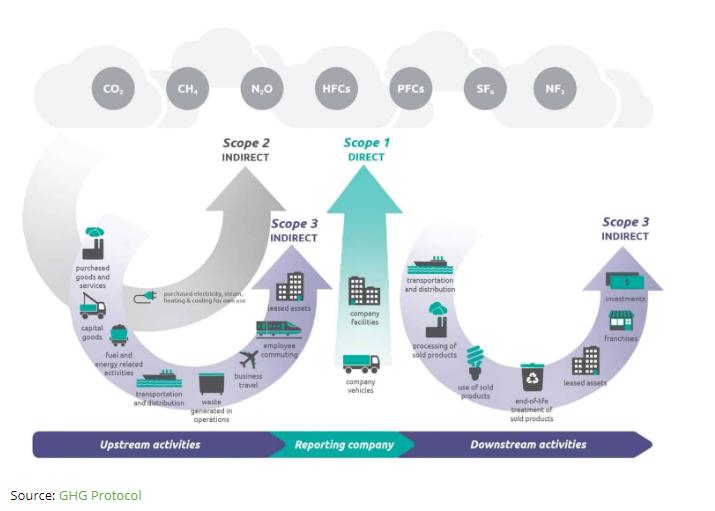It's a question of Scope.

At 4Group, we want to really reduce our emissions as much as we possibly can. We have stated that fact and want to see it through openly and honestly.
Well, honestly, it’s a right pain! When you actually sit down to measure and understand what your business produces in the way of emissions and pollution it is a maze of terms, tools and views that you have to negotiate and yet still run your business.
There are myriad on-line tools out there, but they seem to either work on the basis that you are a family or a multinational. Small and medium sized businesses seem to fall between the cracks here.
Working on this has led me to think we need a simpler way of looking at it, a way we can actually manage. I posed the question to The Carbon Trust, a major company in the field of measuring and reporting emissions for business and governments. They gave me a nice, simple solution: Look at your business. Identify the, say, 10 largest ways you pollute and measure them. Don’t worry too much now about all the dozens of smaller ways – start with the big stuff, it’s a clearer target.
Armed with that thought I took a fresh view. Here’s what I found.
Scope
Emissions can be broken down into 3 main areas called Scopes.
Scope 1 – Direct. The mess you make doing business. Your locally created emissions, vehicle and buildings. This includes oil gas burnt for processes.
Scope 2 – Indirect. The energy you buy in from outside. Easy in Jersey – your electricity usage from the JEC.
Scope 3 – Indirect. Both upstream(buying) and downstream(selling) goods and services, transport and travel. Also includes employee commuting, business travel and customer use of your products…
Hopefully, the diagram above shows what I mean.
Measuring and understanding
How do you measure all of this? Again, start with the big targets and work through. Your scope 1 (vehicle fuels, building heating oil & gas etc) take from your bills and list the energy in whatever units it is sold to you.
Scope 2 is the simplest – Look at your electric bill and note the units (kWh actually).
Scope 3 is the tricky one. 4Group brings in a lot of equipment from the Uk as freight, but it could be bananas. We are working on finding the emissions footprint of local freight at the moment. Another large source of emissions is from when our diggers are built – I have asked our suppliers for figures.
But, there are other large sources of emissions that take a bit of work. Employee commuting for instance. A quick survey of staff will provide some answers for you. Find out how much fuel is consumed in their journeys. It may also help you with your parking problems, you never know. We are looking at:
- Freight (in and out of Jersey)
- Equipment manufacturer
- Staff commuting
- Our waste and rubbish
- The use of our equipment by customers
That last one, the actual use of our diggers and vans, is interesting. We have known for a while that, by far, the largest creator of emissions from 4Group is customers actually using the equipment – it stands to reason. We created an analytic tool to report the estimated fuel use of every machine and it is around 8 times what we create from running the business. We are a facilitator of emissions. It is such an important contributor that we must measure this and understand how we can manage it.
Changing things
You could measure all of these things, come to a total of emissions and then just offset it – you could shout about it and feel good. Or could you?
The reason to measure emissions isn’t to just pay it off. It is to understand how to reduce it.
Emissions are wasteful – a waste of resources, a waste of energy and waste is the enemy of business. Surely, we strive to become a more efficient business because efficiency affects the bottom line. Why is environmental sustainability any different?
For any business, the next few years will be crucial. Those who grasp the nettle will develop new ideas and methods which will change business forever, and for the better.
In business, reducing where you waste resources means reducing where you waste money. By measuring and understanding the production of emissions, you understand your business more and this leads to, not only a more environmentally sustainable, but crucially a more financially sustainable business.
Most businesses have suffered over the past 2 years from factors outside of their control. Is this not the time to re-assess how we work we do and take that leap to change?
What about the tools?
Because the path to sustainability is a shared, collaborative one, we are working with many different organisations and businesses to find tools that are both effective and easy to use for all businesses to use. Whether you are a shoe shop or a building facilities management group, the tools are the same, but they tend to be massively complicated. If we all work together, we can come up with tools that reflect local businesses and help us all on the route we must take.
I will try my best to update this page with links, tools and tips that may help you. If you find something you think would help – please let me know…
